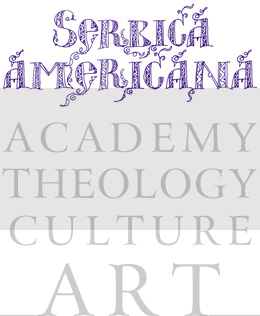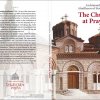A great man is one who collects knowledge the way a bee collects honey and uses it to help people overcome the difficulties they endure - hunger, ignorance and disease!
- Nikola Tesla
Remember, remember always, that all of us, and you and I especially, are descended from immigrants and revolutionists.
- Franklin Roosevelt
While their territory has been devastated and their homes despoiled, the spirit of the Serbian people has not been broken.
- Woodrow Wilson
Latest Articles
- Crafting Pišanice - Serbian Easter Eggs with Natural Dyes
- From Nicaea to Today: The Enduring Legacy of Synodality and Unity in the Church
- The Role of the Deacons in the Church
- The Circle of Serbian Sisters
- Vinka Ellesin
- Богородица као екстатично биће
- Bishop Maxim's Homily During the Assembly of Bishops XII Opening Liturgy
- Leon Joseph Lysaght Jr.
- Olga Gradojevich
People Directory
Natalija Nogulich
NATALIJA NOGULICH, newly published author of her debut novel, ONE WOMAN’S WAR, just performed in the season finale of NCIS, followed by an episode of Disney’s KICKIN’ IT. She also recently completed Season One of ABC series, RED WIDOW, as Russian mob wife, Elena Petrova. In March, Natalija appeared in HBO’s biopic, PHIL SPECTOR, as Italian journalist, Giovanetta Ricci; on Disney Channel in WIZARDS OF WAVERLY PLACE REUNION starring Ms. Nogulich as Carmela.
. Read more ...Publishing
The Church at Prayer
by Archimandrite Aimilianos of Simonopetra
Publisher’s note
Many readers of the addresses of Elder Aimilianos, which have been published in the five-volume series, rchimandrite Aimilianos, Spiritual Instructions and Discourses (Ormylia, 1998-2003), have frequently expressed the wish for an abridged and more accessible form of his teaching. In response, we are happy to inaugurate a new series of publications incorporating key texts from the above-mentioned collection. Other considerations have also contributed o this new project, such as the selection of specific texts which address important, contemporary questions; the need for a smaller, more reader-friendly publication format; and the necessity for editing certain passages in need of clarification, without however altering their basic meaning.
Above all, the works collected in this volume reflect the importance which the Elder consistently attached to prayer, spirituality, community life, worship, and liturgy. Thus the experientially based works "On Prayer", and "The Prayer of the Holy Mountain", which deal primarily with the Prayer of the Heart, appear first, followed by the summary addresses on "The Divine Liturgy", and "Our Church Attendance". These are in turn followed by the more socially oriented discourses on "Our Relations with Our Neighbor", and "Marriage: The Great Sacrament". Finally, the present volume closes with the sermons on "Spiritual Reading" and "The Spiritual Life", which in a simple and yet compelling manner set forth the conditions for "ascending to heaven on the wings of the Spirit".
It is our hope that The Church at Prayer will meet the purpose for which it is issued and will serve as a ready aid and support for those who desire God and eternal life in Him.
Latest US News
- Волт Богданић: Американац српског порекла добитник три Пулицерове награде за истраживачко новинарство
- The American Srbobran - Building a Partnership with the Library of Congress and Institutions in Serbia
- „Американски Србобран“ унапређује сарадњу са Конгресном библиотеком у Вашингтону и институцијама у Србији
- Преминуо чувени амерички песник српског порекла Чарлс Симић
- Јован Дучић међу великанима у кливлендској башти
- Србија, Африка, Америка и Канада славе дан Теслиног рођења
- Документарац Немање Станковића приказан у Холивуду
- Tesla Rhapsody
- Saved by Beauty: Dostoevsky in New York
- Izložba likovnih radova o Dostojevskom
- Steve Popovich - the man who discovered Meat Loaf
- Odlazak čoveka koji je mnogo uradio za očuvanje sećanja na lik i delo Nikole Tesle
- Naš otac Balkanac za Ruse je smislio bijelu Coca-Colu
- Neverovatan poduhvat srpske pravoslavne zajednice u Americi
- Prva Srpkinja u finalu najveće evropske nagrade za pronalazače
Latest Serbia News
- На Станфорд листи 15 крагујевачких научника
- Naše postojanje skriva mračne i svetle strane, i veliko je umeće prepoznati ih i razlučiti
- Српска застава је најлепша на свету – на основу резултата анкете милион људи
- Недеља америчке културе
- Preminuo pisac Aleksandar Petrov
- Spomenik Branku Pešiću radiće srpski vajar iz Los Anđelesa
- Metropolitan Amfilohije buried in the Cathedral church in Podgorica
- Memorial prayer rite for Metropolitan Amfilohije in the Cetinje Monastery
- На данашњи дан рођен је Михајло Идворски Пупин
- Алекса је стигао до Принстона, али Математичкој гимназији се радо враћа
- Каубој православац и 40 Американаца посетили Косово
- Архив Војводине: Сведочанства времена у спомен на херојске претке
- Премијера „Теслиног народа“ на Коларцу
- Када се велики умови играју науком о подацима
- Američka vojska donirala je vrednu opremu klinici u Nišu



